The best ice cream maker
It's not too late in the season to buy one.

By Marguerite Preston and Lesley Stockton
This post was done in partnership with Wirecutter. When readers choose to buy Wirecutter's independently chosen editorial picks, Wirecutter and Engadget may earn affiliate commission. Read the full guide to ice cream makers.
After researching for 95 hours, testing 16 machines, talking with pro ice cream makers and a food scientist, and churning gallons of the frozen stuff since 2014, we think the Whynter ICM-15LS is your best bet for making consistently great ice cream at home. It's not cheap, but because it's so easy to use and it essentially guarantees success, it would likely get a lot more play in your kitchen than cheaper, more finicky machines.
The Whynter ICM-15LS not only made some of the smoothest ice cream in our testing but also ranked as the quietest-running maker we tried and the easiest to scoop from and clean. And since it's a self-refrigerating compressor machine, you won't have to deal with freezing an insert bowl or futzing with messy ice and salt.
If the Whynter ICM-15LS sells out, or you just want more bells and whistles, the Breville Smart Scoop is a great alternative. Although it made slightly creamier ice cream than our top pick, the difference was so subtle that we don't think it's worth the extra $100 or more for most people. It has an auto function with 12 hardness settings and a keep-cool function so you can set your ice cream and walk away. And its brightly lit LCD screen and control panel with big buttons make it easy to use—even for kids.
The Lello 4080 Musso Lussino is the crème de la crème of home ice cream makers. In our tests the large, sleek machine churned out smooth and creamy batches of ice cream in less than 30 minutes, the fastest of any model we tried. And our tasters unanimously voted its ice cream the smoothest and best-flavored. But its jaw-dropping price makes the Musso Lussino too expensive for casual dessert-making. If you plan on making more than a quart of ice cream a week, this might be the machine for you.
If a $200 price tag on an ice cream maker sounds steep to you, consider the affordable Nostalgia ICMP400, which is just one step beyond old-fashioned hand-crank models. While it still requires you to add ice and salt to freeze the mixture, this machine is fitted with a motor to do all of the hard work for you. In our tests its ice cream was slightly icier than that from our main pick but still tasty. It makes up to 1 gallon at a time, and as long as you have enough ice and rock salt, you can turn ice cream all day.
If you own a KitchenAid stand mixer, we really like the KitchenAid Ice Cream Maker KICA0WH attachment, as well. This is a bowl that requires prefreezing, which necessitates more planning ahead than our main pick. In our tests it made the absolute fluffiest ice cream of the machines we tried, since the lowest setting on the KitchenAid stand mixer is still faster than the speed at which ice cream makers spin. We didn't mind the texture at all; in fact, it was quite pleasant.
Why you should trust us
The original version of this guide was written by Wirecutter staff writer Lesley Stockton, who has made a lot of ice cream and frozen yogurt over the course of her long culinary career. As a fresh-faced line cook in New York City, she hung out in the pastry kitchen as much as possible, learning about ice cream from the pastry cooks. She also had to spin a horseradish crème fraîche sorbet, served as a garnish on tuna tartare, every day before service.
Marguerite Preston, who conducted testing for the 2017 update, is a former professional baker with a passion for pastry in general and ice cream in particular. She has also worked on guides to cake pans, waffle makers, pie plates, and more for Wirecutter.
For this guide, we spoke with several ice cream experts, including Brian Smith, co-owner of Ample Hills Creamery; Billy Barlow, then director of culinary and production at Blue Marble Ice Cream; Lauren Brown, avid home ice cream maker and one half of Red & Brown; and Douglas Goff, a professor and food scientist at the University of Guelph with more than 30 years of experience in the field of ice cream. We read reviews from Cook's Illustrated (subscription required) and Good Housekeeping. Finally, we polled Wirecutter readers to find out what they were looking to pay for an ice cream maker and what features would be most convenient for them.
Who should get this
An ice cream maker isn't an essential kitchen tool, but if you love ice cream and like experimenting with unique flavor combinations, investing in one is worthwhile. Which type you should buy depends largely on how often you plan to use it and how much you want to spend. Generally, you'll find three styles of ice cream makers:
Ice-and-salt: These old-fashioned makers tend to be the most affordable. You set a canister filled with ice cream base in a bucket of ice and salt and you churn the mixture, either by hand or with a motor clamped onto the machine's top. If you want to make ice cream only a few times during the summer months, and you're not looking for the smoothest texture possible, this kind of machine might be a good option. The setup can get pretty messy, which is why it's best for people with outdoor space.
Prefrozen bowl: The most common maker of this type is the liquid-filled insert bowl, which you have to freeze for eight to 24 hours. You then put the bowl into a separate machine that churns the ice cream base. While this option is budget-friendly, the insert bowl takes up valuable space in your freezer. You also can't make back-to-back batches because you need to prefreeze the bowl, which means you'll be able to make only 1½ to 2 quarts of ice cream at a time.
Compressor: This type, a self-refrigerating ice cream maker, is the easiest to use. Just flip a switch, and you can turn out batch after batch of ice cream. These machines can be simple, with just a few buttons to operate, or loaded with automatic settings. Compressor models are the closest you can get to professionally spun ice cream at home. If you're serious about your ice cream making game, this is the style to buy.
How we picked and tested
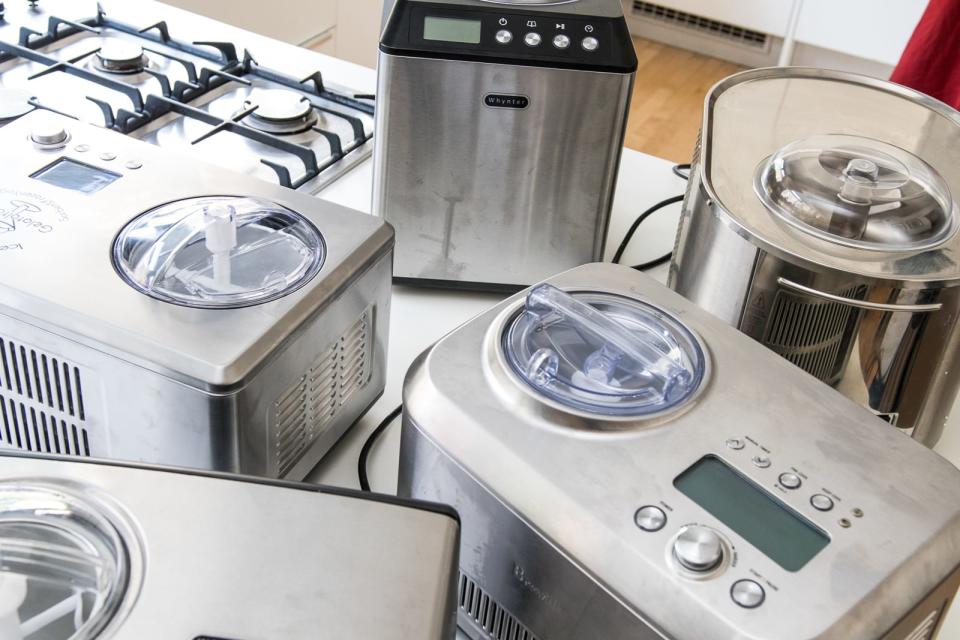
The primary task of an ice cream maker is to produce creamy ice cream with few ice crystals. The faster the mixture freezes, the less time ice crystals have to form. Although machines will do this in about 20 to 40 minutes, there's no optimal time cycle—you just want the mixture to freeze as quickly as possible. That's why compressor machines tend to make smoother textures: They churn and freeze the ice cream base faster than those that rely on frozen inserts or ice and salt.
A good compressor machine will freeze at around -32 degrees Fahrenheit and maintain that temperature until the end of the cycle. A machine that uses a frozen bowl will only get warmer as the mixture freezes (and if your freezer is at the end of a defrost cycle when you take the insert bowl out, you'll end up with a milkshake rather than actual ice cream). You can improve results in any type of machine by making sure your ice cream base is as cold as possible (see our ice cream making tips for how to do this).
While the ice cream base freezes, the dasher—a paddle in the machine—stirs the mixture. Home machines generally have plastic dashers, while pro-level machines (and a few high-end home models) use metal versions. The rate at which the dasher turns, in part, determines overrun: the amount of air whipped into ice cream, measured as a percentage. The faster the dasher moves, the more overrun you have. (Think of it like a whisk whipping cream.) The fat and egg content in a recipe also affects overrun, which we'll get into later.
In our original 2014 test, we tried nine ice cream makers of all types: specialty hand-cranked, electric high-capacity ice-and-salt, frozen insert, and compressor. The only kind we knew we didn't want to try was the large-capacity hand-cranked ice-and-salt type. Those machines are too much of a pain to churn, since they require a strong arm to constantly crank for 20 to 30 minutes.
For our 2015 update, we brought in only self-refrigerating compressor ice cream makers. These models performed the best in our first test—producing the highest-quality ice cream—and in surveying our readers we found that most respondents were looking to buy a compressor machine. We kept our budget and KitchenAid attachment picks the same because no new models of those styles had come out over the past year. The 2015 contenders included the Breville Smart Scoop, Cuisinart ICE-100, Lello 4080 Musso Lussino, Sunpentown KI-15, and Whynter ICM-15LS.

For our 2017 update, we again tested only compressor machines. We pitted two new models—the Whynter ICM-201SB and the Ariete Stainless Steel Ice Cream Maker—against the Whynter ICM-15LS, the Breville Smart Scoop, and the Lello 4080 Musso Lussino, our 2015 picks. Our budget and KitchenAid attachment picks again remain the same, because we've still seen no new models worth testing in those styles.
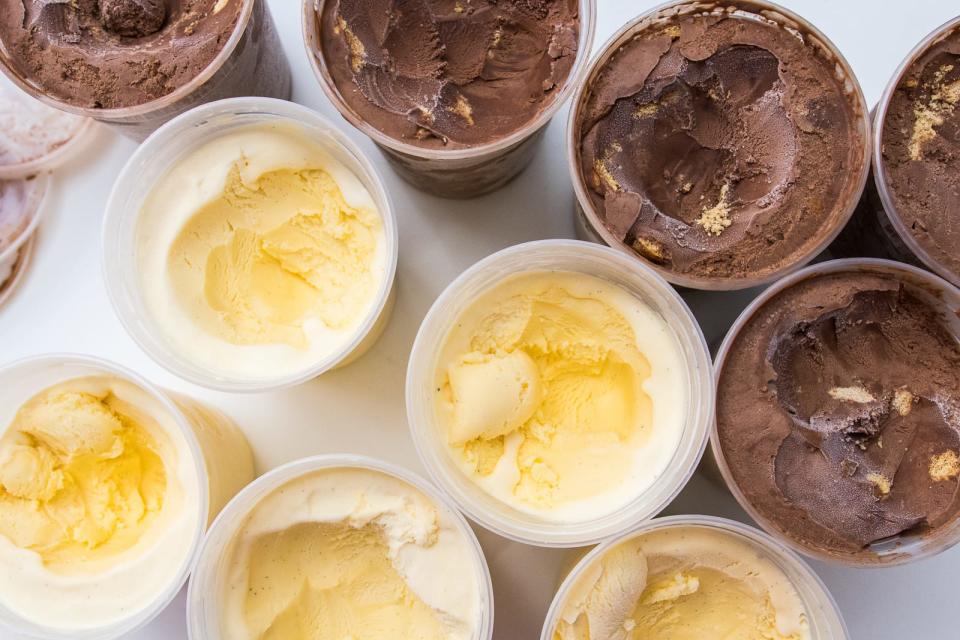
We decided to leave out gelato makers, since gelato is a different animal. It differs from ice cream in that it is mostly milk and sugar with little cream and little to no egg yolks, sometimes using cornstarch to thicken instead. You need to churn gelato slower and at a higher temperature to maintain that "stretchy" quality, which is why ideally you should use a gelato-specific machine for the task. The result is a product with little to no overrun that resembles a custard more than ice cream. Don't get us wrong—gelato is delicious, and we love it. But it's just not the same.
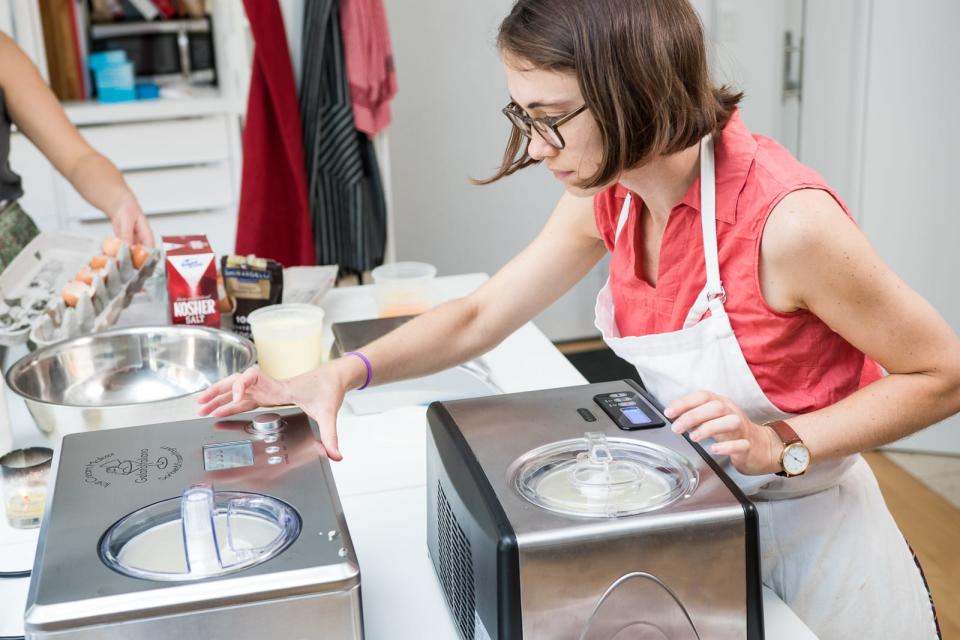
In 2014 we tested the machines using a relatively low-fat recipe from Ample Hills Creamery in Brooklyn, and we tasted the results for texture and flavor with friend Sara Bonisteel, staff editor for the food section of The New York Times (which is now the parent company of Wirecutter). For our 2015 and 2017 updates, we used a higher-fat vanilla ice cream base that contained more cream and egg yolks than the Ample Hills recipe, which had more milk than cream.
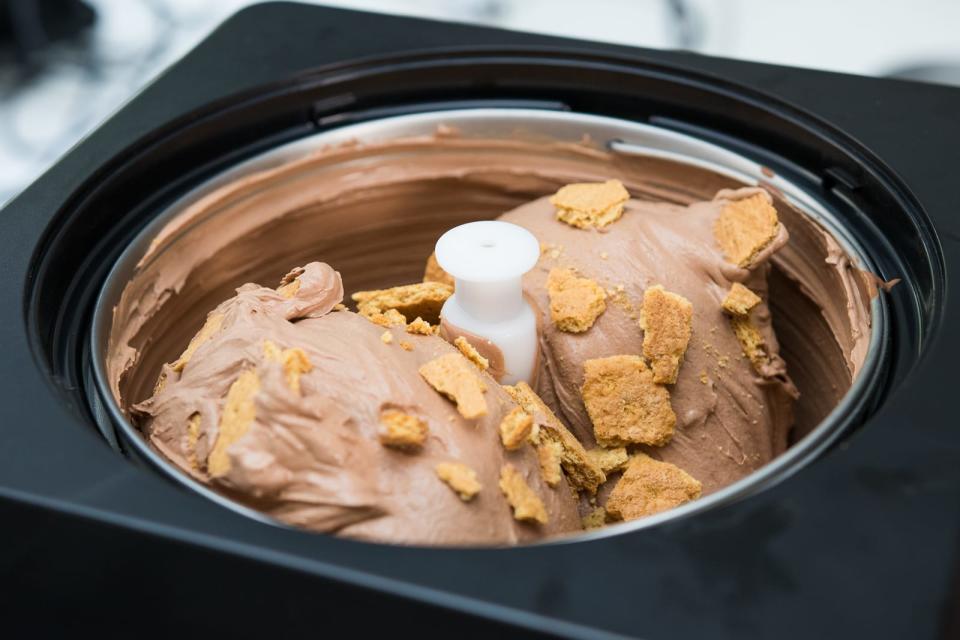
Higher-fat ice cream bases are more forgiving, because they contain a lower percentage of water to crystallize and ruin the creamy texture. If a machine in our tests made icy ice cream from this luxurious base, we figured it wouldn't be worth buying.

In 2015, we also made a simple lemon sorbet without added glucose or corn syrup to smooth out the texture. We thought an unforgiving sorbet recipe that didn't have any aid from fruit fiber or special sugars would show us the differences between these machines. But we were wrong—all the ice cream makers produced the same sorbet, so we did not repeat this test for our 2017 update. Finally, we made chocolate ice cream in each machine, and in 2017 we also used that round to test how each machine handled mix-ins added toward the end of churning. (If you're curious, we used recipes from David Lebovitz, author of The Perfect Scoop.)
In 2015, instead of the informal tasting we held for the original guide, we held a blind taste test with six tasters. For the 2017 update, we returned to an informal tasting, using our former top picks as a benchmark of quality. From our years of testing, we've learned that with ice cream makers, you truly do get what you pay for: The prices of the machines we tested directly reflected the resulting quality of the ice cream.
Our pick: Whynter ICM-15LS

We like the Whynter ICM-15LS because it made smoother ice cream in a shorter amount of time than most of the other models. Although it didn't create the absolute smoothest texture in our tests, it does hit the sweet spot of great results at a reasonable price. It's also one of the quieter machines we tested, and one of the simplest models to use, scoop from, and clean. The simple, compact design makes it easy to store, as well. And because this Whynter model is a compressor machine, no prefreezing of any kind is required.
In all rounds of testing, the ICM-15LS made some of the best ice cream, producing a pronounced creaminess with very few ice crystals. With an overrun of 53 percent, the mixture was quite airy but still very rich. It wasn't as smooth as what we got from the Lello 4080 Musso Lussino, but this machine also costs roughly 60 percent less than that model. As for freezing time, the ICM-15LS churned out creamy ice cream in 33 minutes, falling into second place after the Musso Lussino. Our runner-up, the Breville Smart Scoop, made ice cream in 35 minutes, and the Cuisinart ICE-100 posted the longest freeze time at 42 minutes.
In 2015 we learned that the cost of the compressor machines was directly proportionate to the quality of the ice cream they produced. The cheapest machine, the Sunpentown KI-15, literally stopped working halfway through the cycle and didn't completely freeze the ice cream. Part of the mixture was still liquid, which resulted in uneven, icy ice cream. The Cuisinart ICE-100 was slightly better, but also produced an icy texture. For just a bit more money, the Whynter ICM-15LS made a far creamier ice cream. Both the Breville Smart Scoop and the Lello 4080 Musso Lussino made better ice cream, but they're significantly more expensive. The Whynter ICM-15LS hits the right balance of making really good ice cream at a decent price.
One of the great things about the Whynter ICM-15LS is the lack of noise. It was one of the quietest machines we tested, in stark contrast to our previous runner-up, the Cuisinart ICE-100, which was high-pitched and loud.
The machine itself is pretty compact: Measuring 8½ by 15 by 9¼ inches (height by length by width), it's the smallest of our recommendations. That small size makes the ICM-15LS easier to stash under a workbench or in a cabinet while not in use. Compare that with the Breville Smart Scoop, which measures slightly larger at 9½ by 16½ by 11½ inches, and the Lello 4080 Musso Lussino at 10½ by 17½ by 12 inches. At 32 pounds, it's pretty heavy, but it's easier to pick up and move than our upgrade pick, which weighs 40 pounds. Nevertheless, it's better stored in a low cabinet than on a high shelf.
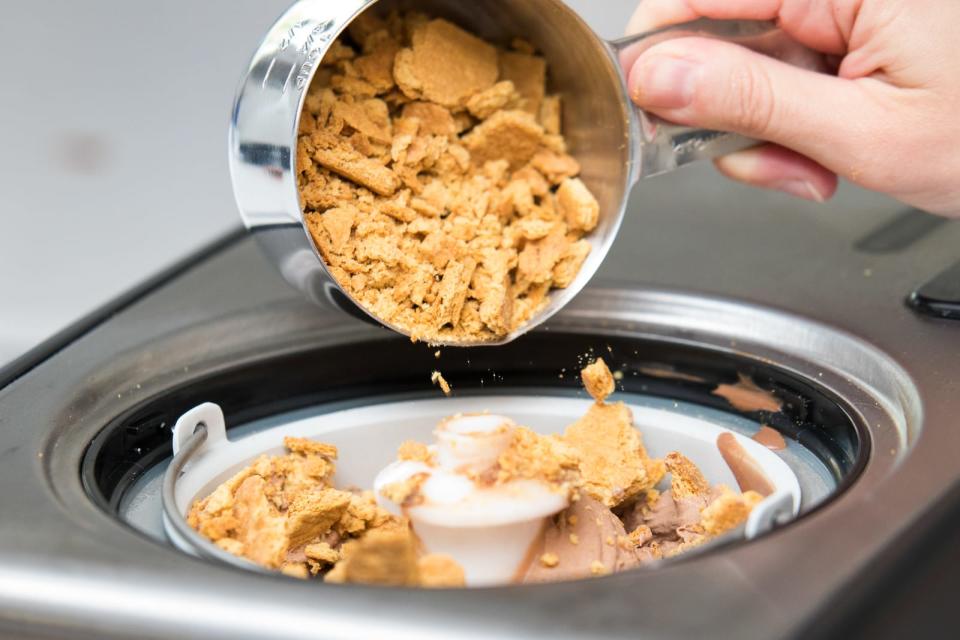
The ICM-15LS is simple to use. The 1½-quart removable bowl is easy to lift out, thanks to a built-in handle, so you can scrape out all the ice cream with ease. The Musso Lussino, on the other hand, doesn't have a removable bowl, so scooping out the finished ice cream and cleaning the machine both get pretty messy. In our tests, setting up the Whynter machine was effortless and took less than three minutes. The Breville was more difficult to navigate; we had to give the manual a once-over and figure out the many buttons and functions before we could start churning.
This machine is also very convenient. It's a compressor model, so it doesn't require ice and nothing needs to be frozen in advance; just pour in your chilled base and turn it on. It isn't any different from the other compressor machines we tested, but it does stand leagues ahead of the insert and ice-and-salt models we tried.
Fine Cooking likes the Whynter ICM-15LS for its value. Our prior pick was the Whynter SNO (since discontinued), and this machine is basically the same guts with a smaller bowl.
Flaws but not dealbreakers
Our previous pick, the Whynter SNO, had a 2-quart capacity, while the Whynter ICM-15LS has only a 1½-quart capacity. The smaller capacity is not that big of a deal, however, because you can run batches back-to-back in this machine since prefreezing isn't required.
The opening for adding mix-ins is almost comically tiny (2½ by 1 inches, versus the Breville's 4¾-by-2-inch opening). But because you can remove the lid and the motor keeps turning, adding mix-ins is pretty easy without fussing with the opening in the lid.
Runner-up: Breville Smart Scoop
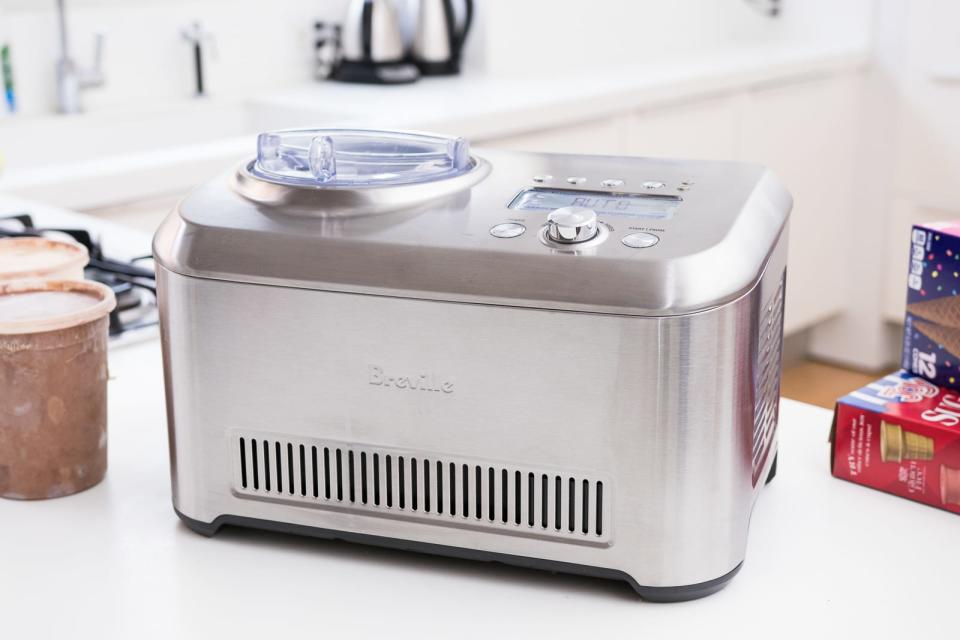
For the price, we think the Whynter ICM-15LS is the best ice cream maker for most people, but the Breville Smart Scoop is a good—albeit substantially more expensive—option if the ICM-15LS sells out. In our tests the Breville model made slightly creamier ice cream than the Whynter, but we don't think that makes it worth the price jump.
The Smart Scoop was our higher-priced option in our original guide, but in 2015 it failed to beat the much more consistent (and expensive) Lello 4080 Musso Lussino. What the Smart Scoop really has going for it are more automatic options—basically a lot of extra bells and whistles that most people probably don't need. It has an auto mode that lets you choose from 12 hardness settings (which seems excessive), from soft sorbet to super-firm ice cream. A bell alerts you when the time is right to add mix-ins, and the lid's wide-mouth opening makes that task easy. When the cycle is done, the Smart Scoop automatically stops turning the ice cream, and an alert bell or an ice cream truck song signals that the cycle is finished (you can turn this off).
A keep-cool function ensures that your ice cream stays frozen and churned for up to three hours. The machine also has a unique cool-down function that brings the temp on your base and the machine down to the perfect turning temperature before it starts to churn—no other ice cream maker in our test group has this feature. The large, bright LCD screen is easy to read, and the buttons are intuitive. And if you prefer, the Smart Scoop also has a manual function that gives you complete control (the Whynter ICM-15LS, in contrast, has no presets).

At 54 percent overrun, the Smart Scoop's ice cream was so smooth and perfectly churned that we could have eaten it straight from the machine, no additional freezing necessary. You could do the same with any of these makers, but the Breville, and the Lello 4080 Musso Lussino for that matter, produce a firmer ice cream straight out of the machine. If you want a more scoopable ice cream, just transfer the mixture to a freezer-safe container and freeze it for a few hours.
At nearly $400 at the time of writing, the Smart Scoop is definitely a splurge. And there's nothing you can do in this machine that you can't do in the Whynter ICM-15LS. But the preset auto functions do take a lot of guesswork out of the timing, which is great for beginners and even kids.
Brian Smith at Ample Hills Creamery told us that he had one of these at his house and that his kids loved to use it, probably because of the cheery jingle that plays when the ice cream is finished churning. It also comes recommended by Serious Eats and Bon Appétit.
Upgrade pick: Lello 4080 Musso Lussino
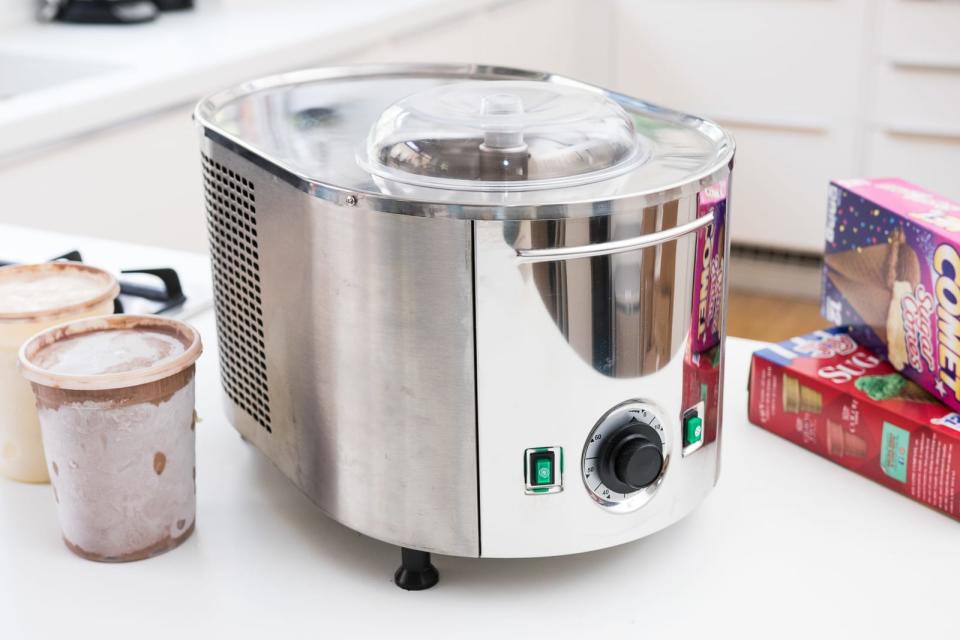
The Lello 4080 Musso Lussino is truly the most luxurious home ice cream maker we've ever used. In our blind tasting, the Musso Lussino took first or second place with every taster. For the price, however, it's worth the investment only if you're a serious connoisseur or you have cash to burn. Musso is an Italian company that sells home and commercial ice cream and gelato makers. The design of the Musso Lussino is sleek and simple with no bells and whistles, but we do have a few small gripes about its build.
The stationary bowl is not fun to clean, especially if the machine isn't situated near a sink. You basically have to scrape out every last bit of ice cream and let the bowl warm up a bit, otherwise your cleaning water will freeze. Then you need to fill a mixing bowl with soapy or bleach water and wipe the machine out, making sure to rinse it completely. The task took more paper towels than we care to use, but we're sure that we could streamline it with practice.
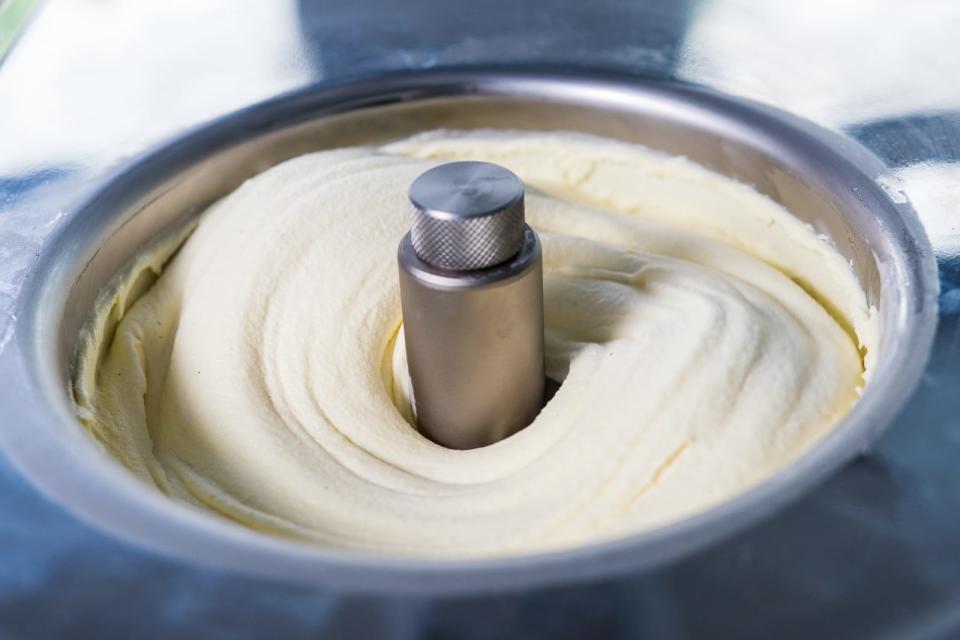
The machine is also really big and heavy, measuring 10½ by 17½ by 12 inches (height by length by width) and weighing 40 pounds. This isn't something you can stash on a shelf; it should be permanently parked on your countertop.
As with the Whynter ICM-15LS, using the Musso Lussino is impressively easy. The metal dasher—all the others in our test group are plastic—sits in the depressed stainless steel bowl. After you pour in the ice cream base, you just set the timer and press the two green buttons, one for freezing and the other for churning; you have no extra controls or settings as on our runner-up. We aren't sure why the Musso Lussino has two separate buttons, but the cooling button could be helpful for keeping the ice cream cold once you turn off the churn button—just remove the dasher so that it doesn't get frozen into the mixture. In our tests, this machine took 22 to 25 minutes, posting the quickest churning time of all the models we tested. What does that speed get you? Less ice-crystal formation and an intense creaminess that's reminiscent of store-bought premium ice cream, thanks to a more powerful compressor that freezes the mixture faster. The difference is evident when you scoop out the finished product, as it's stretchy, like gelato, and visually smoother. The Whynter ICM-15LS and Breville Smart Scoop turned vanilla ice cream in 33 and 35 minutes, respectively, and their product was more icy.
But, again, the Lello 4080 Musso Lussino is really expensive. For it to pay for itself, you'd need to make 1 quart of ice cream at least once a week for two and a half years. For the same price you could easily buy 275 pints of premium ice cream from a store at $5 per pint, if you factor in the cost of the Musso Lussino plus quality ingredients (and why use anything but in such a machine?). But if you like to make ice cream for family and friends on the regular, and you have the money, this just might be your ideal ice cream maker. Like the other machines we picked, this model comes with a one-year warranty, which is a bit short given the hefty price tag.
Budget pick: Nostalgia ICMP400
If you're not ready to commit to an expensive compressor machine, the Nostalgia ICMP400 offers good results, although it requires more work and won't produce the creamiest textures. Of the two models we tested that required ice and salt, the Nostalgia was the winner. This simple machine can make up to 4 quarts of ice cream, easily twice the capacity of the others.
The Nostalgia produced decent ice cream with a lower overrun of 31 percent, which is on the dense side. While the ice cream was a bit icy, it wasn't the biggest offender in our testing lineup. Sara Bonisteel preferred this machine's ice cream over that made in the equally affordable Hamilton Beach 68330R, noting that it had a "nice bite" and "pretty nice texture" with a "hint of ice crystal." The flavor of the cream really came out in the finish. (We didn't test this model again with the higher-fat recipe. It's very possible that with a different recipe, this machine would yield an ice cream with higher overrun.)
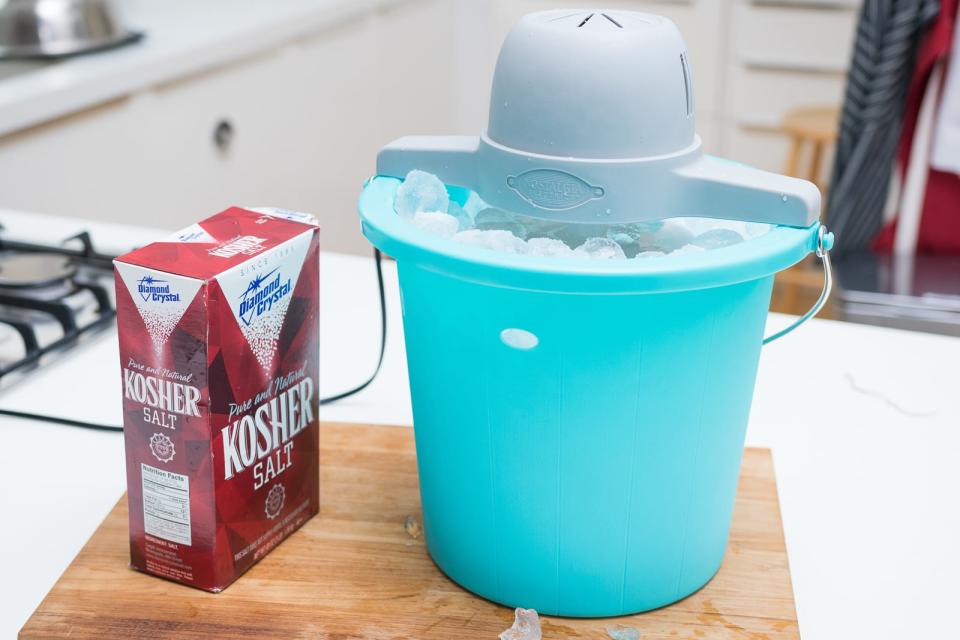
The construction is simple, with a canister, a cover, a dasher, a bucket, and a motor that fits over the top. You just layer ice and salt in the bucket around the canister and plug in the motor. (We used kosher salt because we couldn't find ice cream rock salt, and it worked just fine.) The bucket has a big, comfortable handle, and the motor runs at a low hum. In our tests the ice cream took about 30 minutes to churn, but the bucket was only a quarter full; at full capacity, the process would've taken longer. Since it was a cool day, we didn't need to add more ice.
Keep in mind that this machine isn't designed for you to add mix-ins while it's running. You have to remove the motor and lid to add anything to the canister. Even then, you run the risk of accidentally getting salty ice in your ice cream. Best to stir in any additional nuts, cookies, or candy by hand after it's done churning.
For KitchenAid stand-mixer owners: KitchenAid Ice Cream Maker KICA0WH
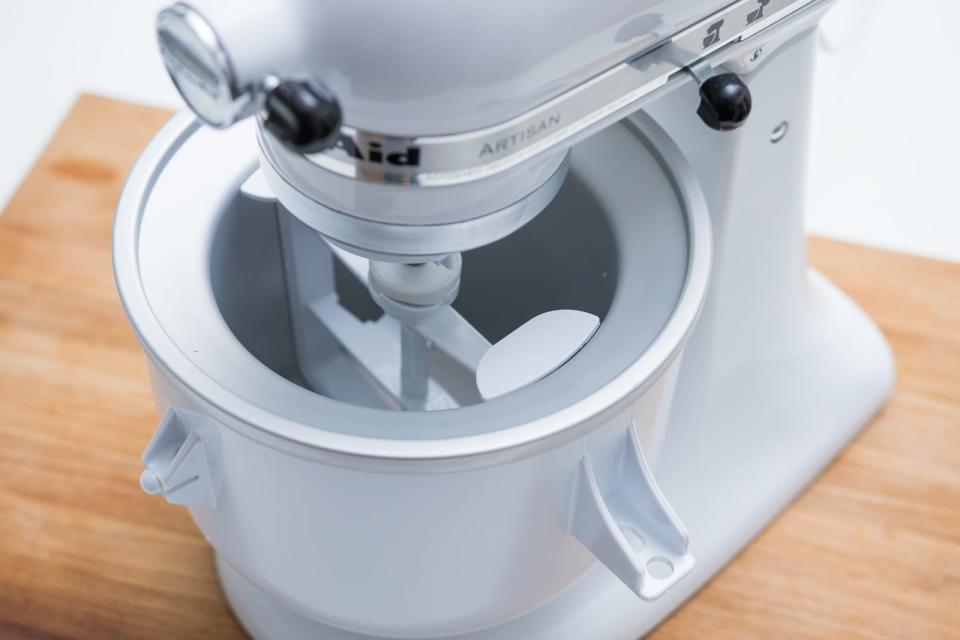
While we were not impressed with other frozen inserts, we found that the KitchenAid Ice Cream Maker KICA0WH attachment was the only frozen-bowl model that worked well consistently. It's a space-saving, affordable alternative if you have a KitchenAid stand mixer from 1990 or later.
The KitchenAid KICA0WH made perfect, fluffy ice cream every time. And we do mean fluffy, with the highest overrun (68 percent) in our tests (using the lower-fat recipe). The lowest speed on a KitchenAid is still faster than the churn speed on all of the ice cream makers we tested, so the resulting ice cream was smooth and extremely airy, with few discernable ice crystals. If you like a denser ice cream, this is not the maker for you.
Because of the fluffier texture, the flavors also weren't as pronounced, and we didn't get an especially indulgent mouthfeel. Billy Barlow, then culinary and production director at Blue Marble Ice Cream, told us he used this attachment because he already owned a KitchenAid mixer and he had space constraints in his New York City home. He noted that while you do have control over the speed while using the KitchenAid attachment, if you run it too fast, the friction will prevent your ice cream from setting. We ran it on the lowest speed, and it worked really well.
This attachment comes highly recommended by Good Housekeeping. Cook's Illustrated(subscription required) recommends it with reservations because of the high overrun.
Ice cream making tips
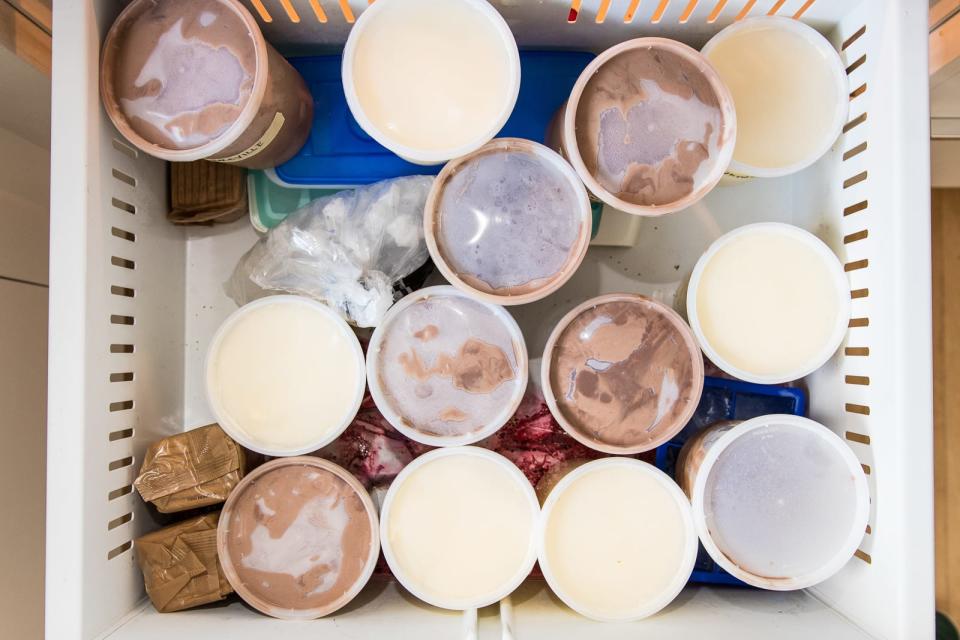
Even the best home ice cream machine will never make ice cream quite as smooth as the stuff you can buy in the store, which is churned more quickly at lower temperatures, preventing ice crystals from forming. But you can take some steps to greatly increase the quality of your homemade ice cream, mostly by making sure it stays as cold as possible through every part of the process. Here's how to get the most out of any ice cream machine:
Before you spin your base, thoroughly chill it down in an ice bath, or even let it chill in the fridge overnight. The colder the base, the sooner it starts to freeze, and the smaller the ice crystals will be. There is no skipping this step, unless you have a Breville Smart Scoop, which can do it for you.
Once the ice cream is spun, it's like soft serve—it's completely edible but definitely not scoopable. This is the point where you "ripen" the ice cream, which means transferring it to a container to freeze for at least a few hours. Additional freezing is an important step, because it reduces the formation of ice crystals; the colder your freezer, the quicker your ice cream sets, and the smaller those ice cream crystals will be.
If you're interested in adding mix-ins, do so before ripening the ice cream. The ice cream base expands as the dasher whips air into the mixture. In our testing, we found that once the quart of base increased in size, it had little room for much else, and we needed to add mix-ins slowly and periodically. Maybe that's the reason the Ample Hills cookbook suggests adding all mix-ins by hand once you've transferred the ice cream to a storage container. Also, if you are adding mix-ins, chill them in the freezer so they don't melt your freshly spun ice cream.
If you're new to ice cream making and aren't sure how long to churn, no worries with the Whynter ICM-15LS: That machine has an automatic shut-off function, so it won't suffer damage if your mixture happens to freeze solid. Otherwise, remove the ice cream from the machine when it's thick and about the consistency of soft serve.
Also make sure the outside of the bowl is dry before placing it in the machine. This is a tip that Breville's instructions specifically call out so that the bowl doesn't freeze into the machine, and it's a good idea for all ice cream makers with removable bowls.
What is overrun?
The term overrun refers to the amount of air whipped into the ice cream. There's no optimal overrun, as commercial ice cream overrun can range from the super-dense 24 percent (Häagen-Dazs) to the light and fluffy 94 percent (Breyers), according to Cook's Illustrated(subscription required). Think of it as the difference between pudding and mousse—they're both stirred custard desserts, and they're both delicious.
The air whipped into ice cream actually plays a role in texture and flavor delivery. Billy Barlow of Blue Marble Ice Cream said, "Air is very important when you take into account texture, as well as whenever you incorporate air into a product; if you have mint or vanilla in your ice cream, something that's aromatic, those air capsules actually hold the aroma of whatever it is you're flavoring with." Ice cream that has a higher fat content holds more air. Not only that, but those air capsules also deliver better mouthfeel and texture.
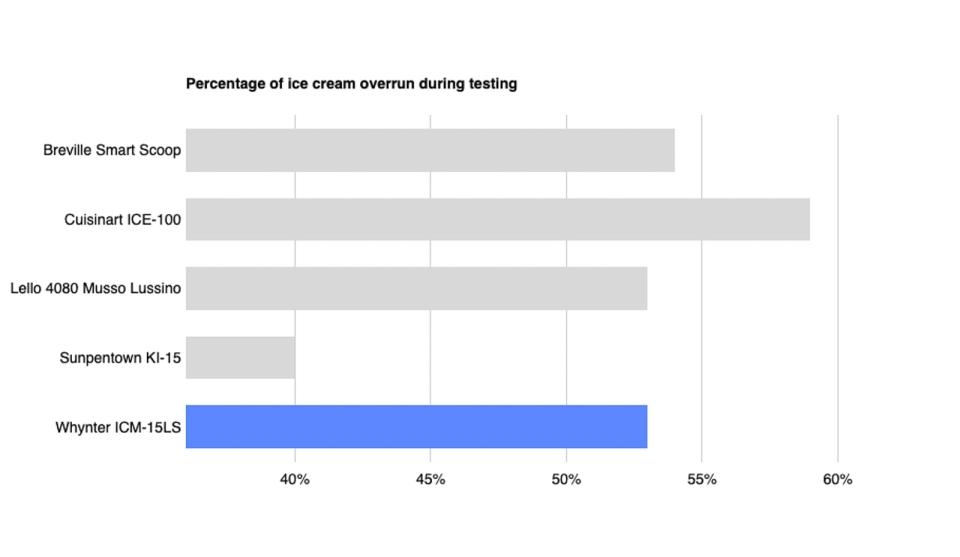
Cheap ice cream makers cut corners with cheap ingredients and high overrun. In the commercial ice cream business, more air means higher profits for producers. Douglas Goff, a food scientist with extensive experience in ice cream, told us, "Manufacturers are caught in the middle of ingredient and fixed costs on the one hand (which keep going up) and retailing demands for price point on the other hand (can't go up), so overrun is a way to try to straddle that line and keep up margins."
He went on to explain how that affected the quality of the finished product: "Yes, it is one of the defining characteristics of quality—too low and it is very dense, heavy, and rich (Häagen Dazs as the quintessential example, that is their market niche), and too high and it is too marshmallowy/fluffy, the cheap supermarket no-name brands being a good example."
If you're a fan of both fluffy texture and high-quality ingredients, the best way to have the ice cream of your dreams is to make it yourself.
The competition
The Whynter ICM-201SB is a newer Whynter model than our current pick, and at 2.1 quarts it has a larger capacity (the Whynter ICM-15LS makes 1.5 quarts). But it didn't make ice cream significantly better than our current pick, and at the time we tested it was more expensive as well. However, if you can find the 201SB for cheaper than our pick, we think you'll be perfectly happy with it.
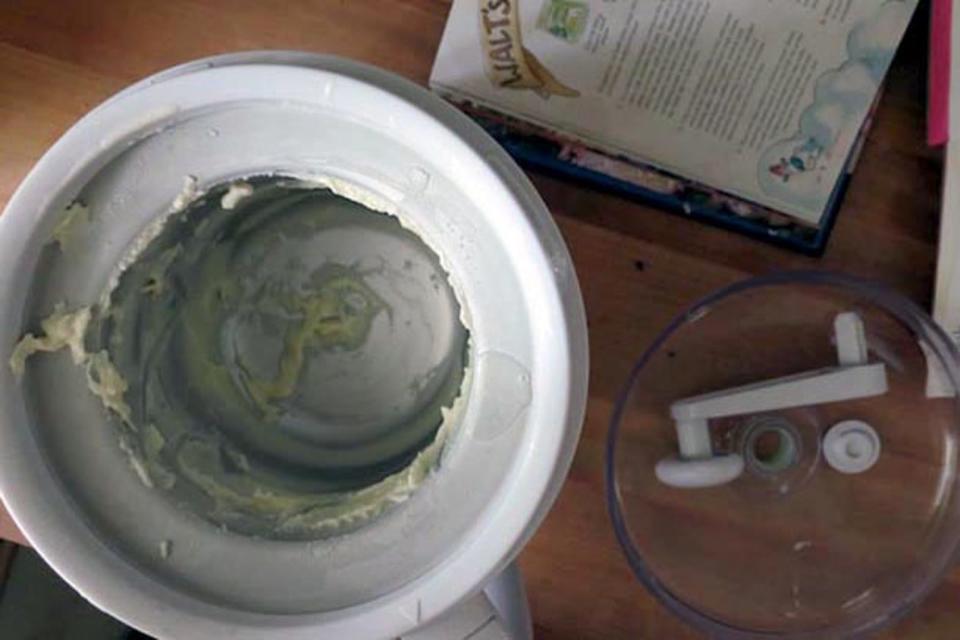
Our previous runner-up, the Cuisinart ICE-100, fell from grace after 2017's testing round. Pitted against other compressor models, it couldn't compete and came in dead last. It took the longest to churn ice cream, 42 minutes, and the result was the iciest in our testing group.
The Sunpentown KI-15 was an underperformer. It churned the vanilla ice cream base with ease, and our blind-tasters liked its results a lot. But that's where the good news ends: It stopped churning the lemon sorbet and chocolate ice cream before the mixtures were completely set, producing an icy and uneven texture.
The Donvier 837409W was the only hand-cranked model we tried. The smaller capacity (1 quart) of the frozen bowl probably makes the work much more manageable, as it needs to be turned only four complete turns, every three to four minutes for 20 minutes. But we found that it made inconsistent batches; the first was great, but the second was very icy.
A smaller machine with an insert bowl that requires prefreezing, the Cuisinart ICE-21 generally made icy ice cream in our tests. The ICE-21 does have a large opening in the top for mix-ins, which is a real plus. The biggest disappointment of this model was that when we went to make the second batch the next day, it wouldn't freeze at all. The mixture resembled a half-melted milkshake.
Our prior top pick, the Whynter SNO, has since been discontinued. In our tests it made delicious, smooth ice cream on a par with that of our newer pick, the Whynter ICM-15LS. The SNO is bigger, heavier, and a little louder than the ICM-15LS, but if you happen to find it on closeout somewhere, go ahead and pick it up. We still stand by this maker.
The Whynter ICM-200LS is a slightly higher-capacity, slightly more expensive version of our top pick. A sales representative told us that the machines had the same motor and compressor; the only difference was that the ICM-200LS made 2 quarts of ice cream as opposed to 1½ quarts. We didn't think an extra pint of ice cream was worth paying about $40 more at the time, so we opted not to test.
The White Mountain Appalachian Series 6-quart Electric Ice Cream Maker uses ice and salt and has a motorized dasher. Although it offers an attractive wooden bucket and is made in the USA, it typically costs over $200. Since you can get an easier-to-use compressor machine for that price, we opted not to test.
The Cuisinart ICE-30BC Pure Indulgence is a frozen-insert machine. Cook's Illustrated wasn't entirely pleased with it, and one of the editors here at Wirecutter had an unfavorable experience while owning one.
This guide may have been updated by Wirecutter. To see the current recommendation, please go here.
When readers choose to buy Wirecutter's independently chosen editorial picks, Wirecutter and Engadget may earn affiliate commissions.
